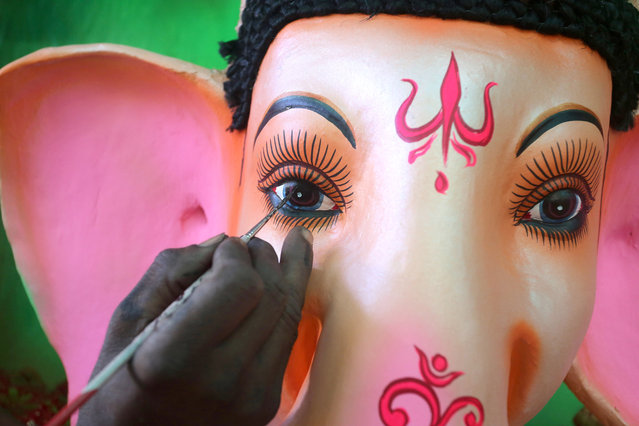
An Indian artist paints an idol of Hindu elephant-headed god Lord Ganesha during the preparations for the upcoming Ganesha Chaturthi festival in Bhopal, India, 16 September 2015. The idol is meant for the forthcoming festival Ganesha Chaturthi, a ten-day long event which is celebrated all over India. During the Ganpati festival, that is celebrated as the birthday of Lord Ganesha, idols of the Hindu deity are worshipped at hundreds of pandals or makeshift tents before they are immersed into water bodies. This year, the festival starts on 17 September 2015. (Photo by Sanjeev Gupta/EPA)
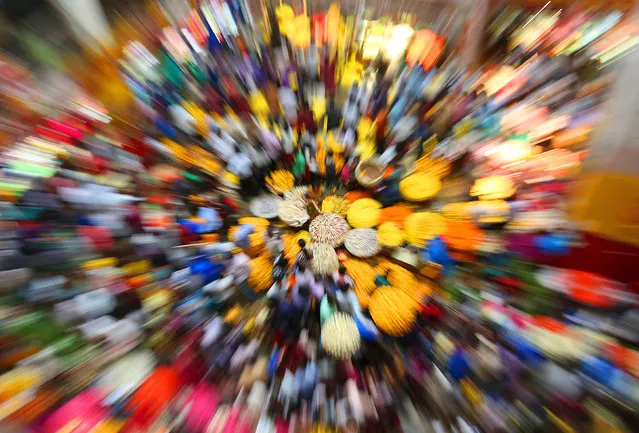
A picture taken with a slow exposure and a zoom effect shows Indian visitors buy flower at a flower market on the eve of Hindu elephant-headed god Lord Ganesh Chaturthi festival in Bangalore, India, 16 September 2015. The ten-day long Hindu festival is celebrated as the birthday of Lord Ganesh and starts on 17 September. (Photo by Jagadeesh N.V./EPA)

An Indian artist gives the finishing touches to a figure of the elephant-headed Hindu god Ganesha at a workshop ahead of the Ganesh Chaturthi festival in New Delhi on September 15, 2015. (Photo by Sajjad Hussain/AFP Photo)
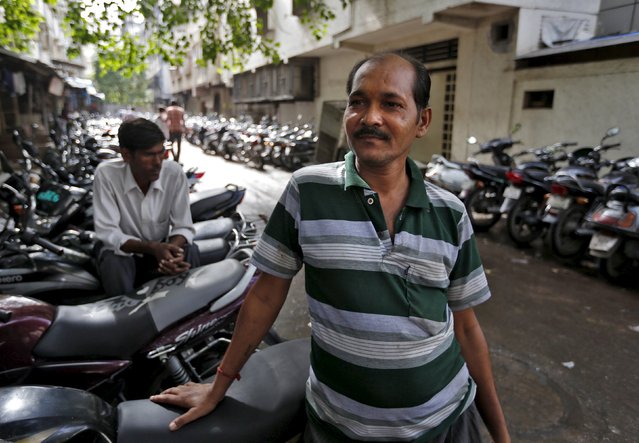
Sunilkumar Rajput, an unemployed craftsman, stands outside a diamond polishing and processing unit where he used to work, at Surat in Gujarat, India, August 31, 2015. Rajput spent 25 years cutting gems in this coastal city, where streets are lined with workshops of all sizes, bustling with craftsmen huddled under desk lamps, preparing to carve rough diamonds into multi-faceted gems. He lost his job in June. More than 5,000 Surat polishers have lost their jobs since June and thousands more could be left without work, as Chinese consumers pull back from luxury purchases, leaving jewellers with stocks of unsold jewellery and gems. (Photo by Amit Dave/Reuters)
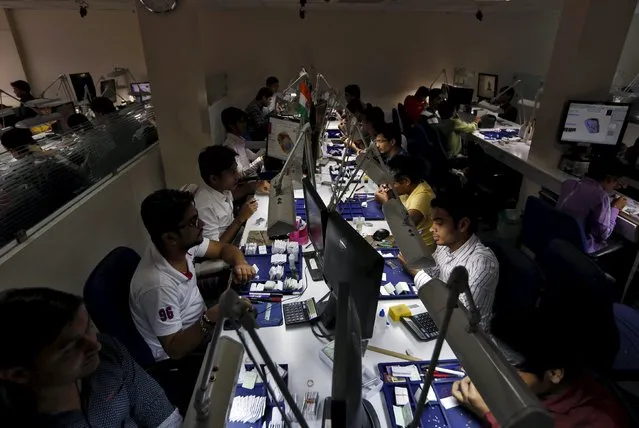
Craftsmen work at the polishing department of a diamond processing unit at Surat in Gujarat, India, August 31, 2015. (Photo by Amit Dave/Reuters)
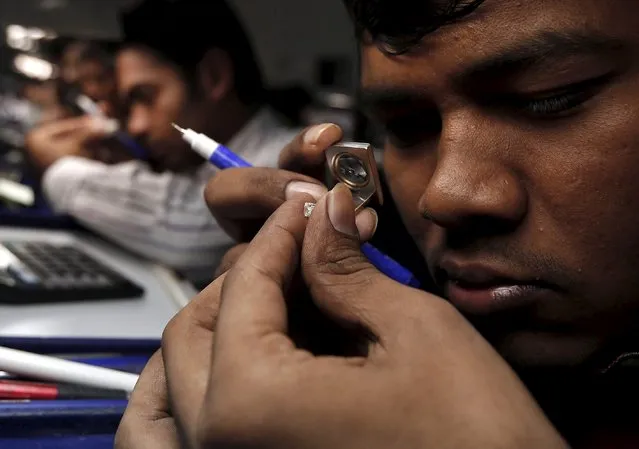
A craftsman checks the colour of a diamond at the polishing department of a diamond processing unit at Surat in Gujarat, India, August 31, 2015. (Photo by Amit Dave/Reuters)
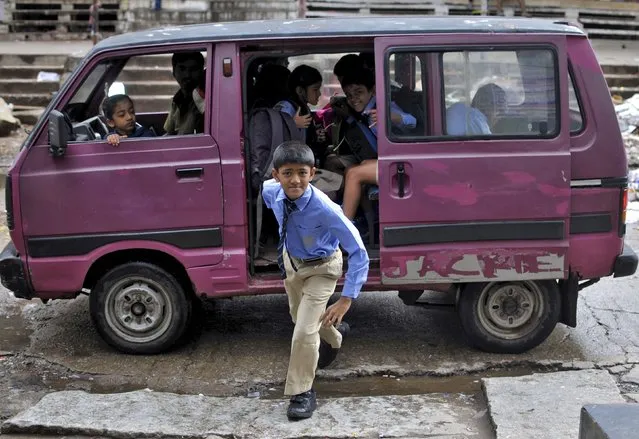
A schoolboy looks on as he alights from a private school van to collect his lunch box on the occasion of International Literacy Day in Bengaluru, India, September 8, 2015. (Photo by Abhishek N. Chinnappa/Reuters)
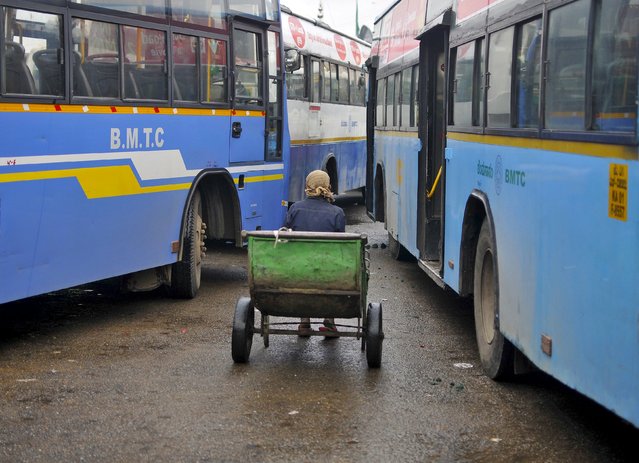
A porter sits in his pushcart as he waits for customers in between passenger buses at a municipal bus terminal in Bengaluru, India, September 8, 2015. (Photo by Abhishek N. Chinnappa/Reuters)
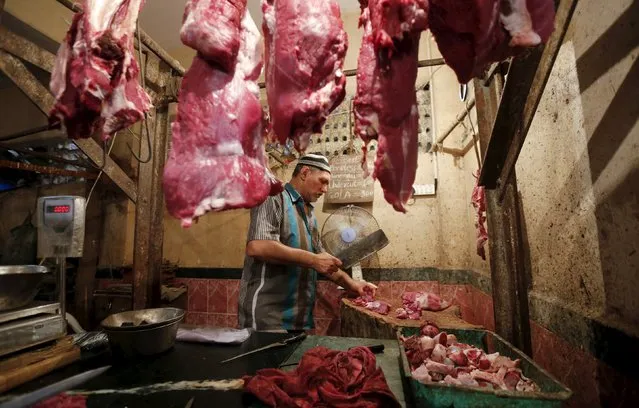
A butcher cuts meat for a customer inside his shop in Mumbai, India, September 8, 2015. India's financial capital has banned the slaughter and sale of meat for four days this month following a demand from the strictly vegetarian Jain community, sparking outrage among meat-eaters already upset by a permanent beef ban imposed this year. (Photo by Shailesh Andrade/Reuters)
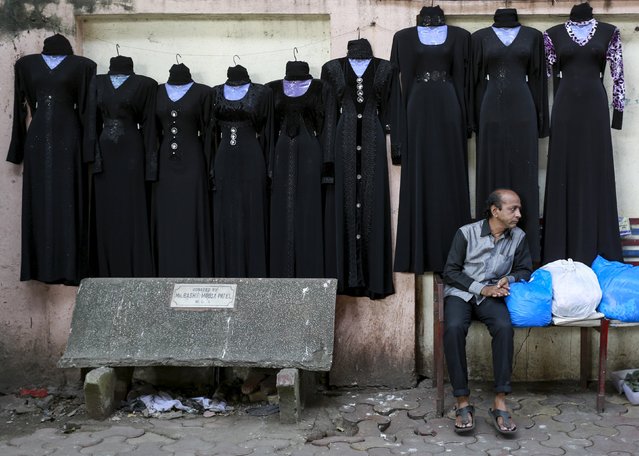
A vendor waits for customers as burqas on sale are displayed on a wall at a market in Mumbai, India, September 8, 2015. (Photo by Danish Siddiqui/Reuters)
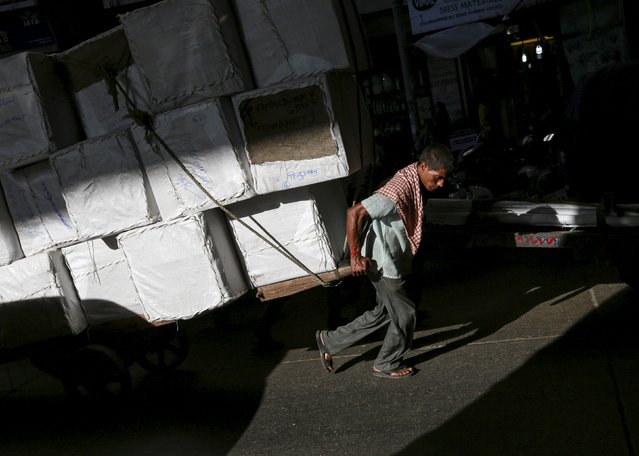
A porter pulls a handcart loaded with goods at a market in Mumbai, India, September 8, 2015. (Photo by Danish Siddiqui/Reuters)
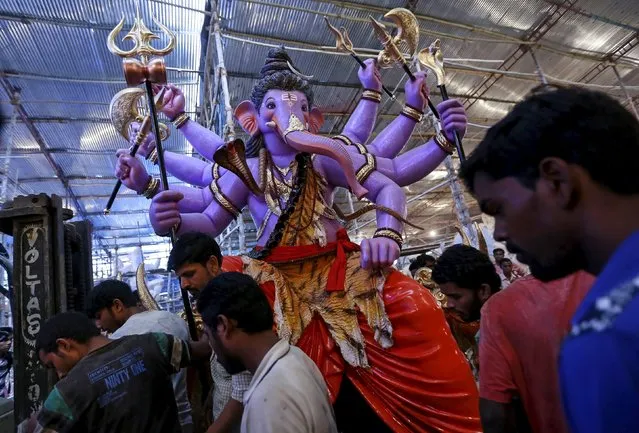
Workers carry an idol of Hindu elephant god Ganesh, the deity of prosperity, as it is transported from a workshop to a place of worship in Mumbai, India, September 9, 2015. Work on Ganesh idols usually begins two to three months before Ganesh Chaturthi, a popular religious festival in India that will be held in September this year. During the festival the idols will be taken through the streets in a procession accompanied by dancing and singing, and to be immersed in a river or the sea in accordance with the Hindu faith. (Photo by Danish Siddiqui/Reuters)
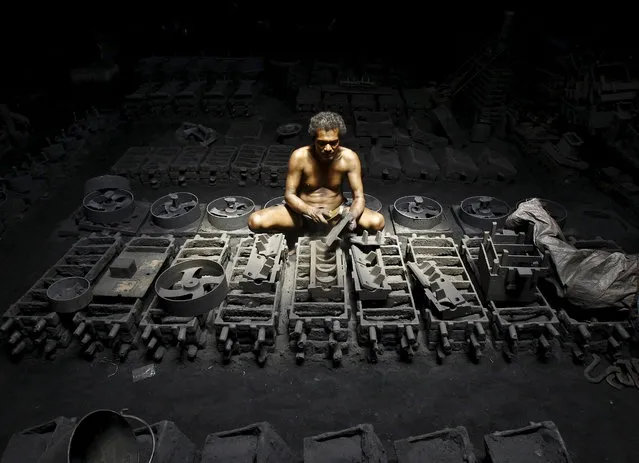
A labourer works inside the manufacturing unit of iron parts at a factory on the outskirts of Kolkata, September 11, 2015. India's annual industrial output growth slowed to 4.2 percent in July compared with an upwardly revised 4.4 percent growth a month ago, government data showed on Friday. (Photo by Rupak De Chowdhuri/Reuters)
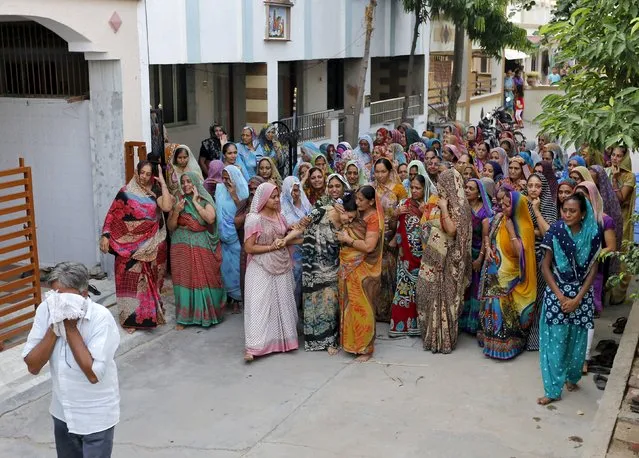
People mourn during the funeral procession of Shantilal Boghra and his sister Bhanu Doberaiya, who died in a cooking gas cylinder blast in central Madhya Pradesh state on Saturday in Ahmedabad, India, September 13, 2015. At least 85 people including Boghra and Doberaiya were killed when a cooking gas cylinder blew up in a crowded restaurant in central India on Saturday, triggering a second blast of mining detonators stored illegally nearby, police said. (Photo by Amit Dave/Reuters)
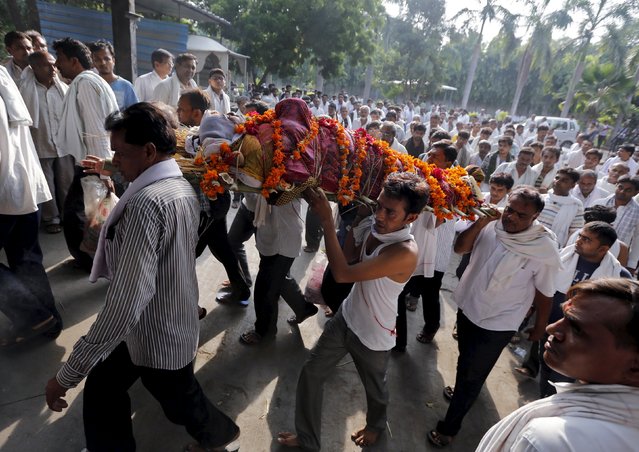
People carry the body of Bhanu Doberaiya, who died in a cooking gas cylinder blast in central Madhya Pradesh state on Saturday in Ahmedabad, India, September 13, 2015. (Photo by Amit Dave/Reuters)
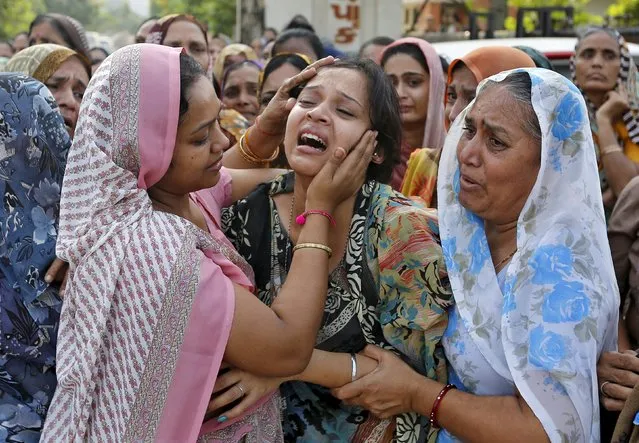
The daughter of Shantilal Boghra, who died in a cooking gas cylinder blast in central Madhya Pradesh state on Saturday, is consoled during the funeral of her father in Ahmedabad, India, September 13, 2015. (Photo by Amit Dave/Reuters)
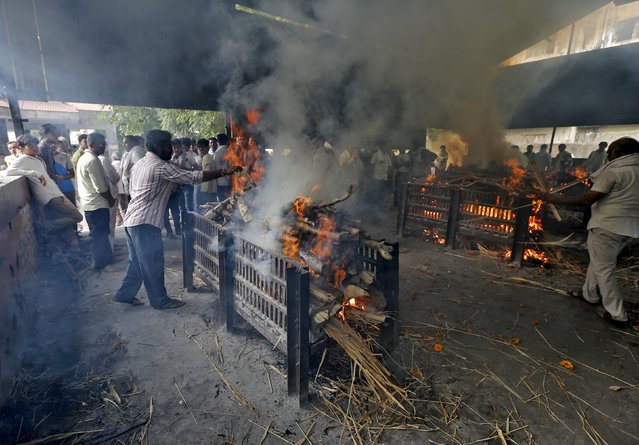
People stand around the pyres of Shantilal Boghra and his sister Bhanu Doberaiya, who died in a cooking gas cylinder blast in central Madhya Pradesh state on Saturday in Ahmedabad, India, September 13, 2015. (Photo by Amit Dave/Reuters)
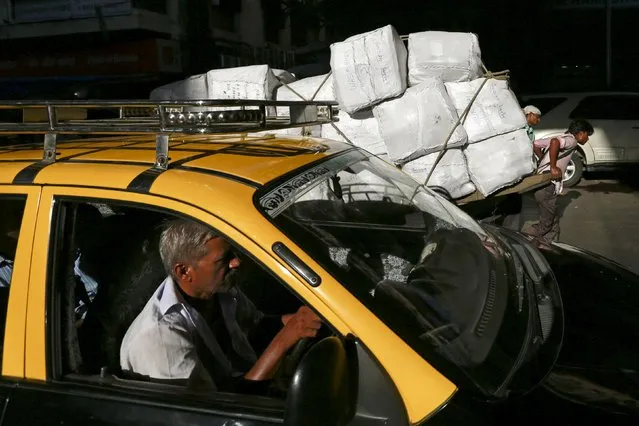
Porters pull a handcart loaded with goods at a market in Mumbai, India, September 8, 2015. (Photo by Danish Siddiqui/Reuters)
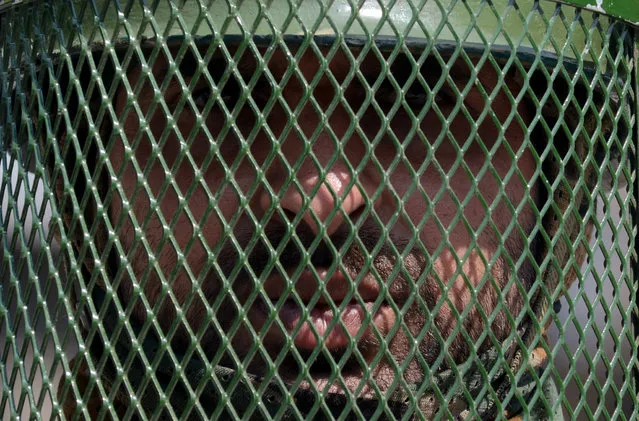
An Indian paramilitary trooper stands guard near a barricade in Srinagar on September 7, 2015. Indian Kashmir mostly shut down September 7 to protest government delays in rebuilding the region hit by devastating floods a year ago, as hundreds of police and troops patrolled the streets. (Photo by Tauseef Mustafa/AFP Photo)
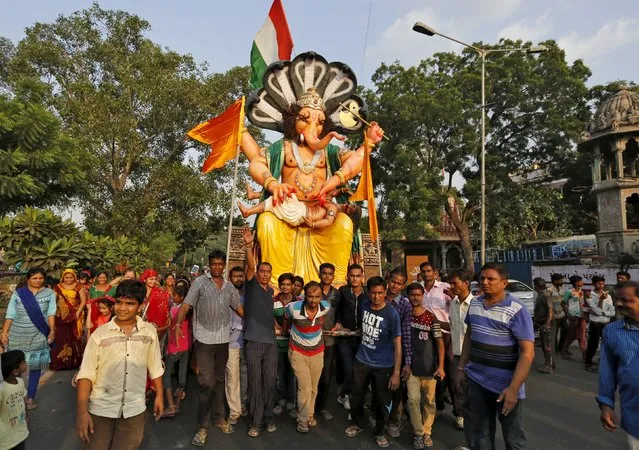
Devotees transport an idol of Hindu elephant god Ganesh, the deity of prosperity, to a place of worship in Ahmedabad, India, September 13, 2015. Idols of Ganesh are made two to three months before Ganesh Chaturthi, a popular religious festival in India. During the festival the idols will be taken through the streets in a procession accompanied by dancing and singing, and will be immersed in a river or the sea in accordance with Hindu faith. (Photo by Amit Dave/Reuters)
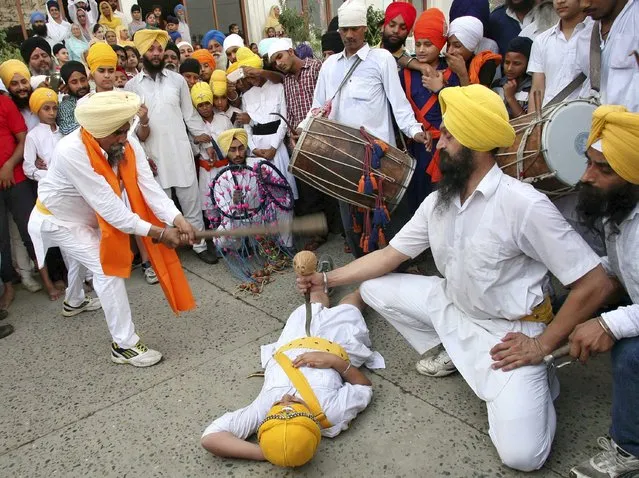
A Sikh performer breaks a coconut with a stick as he performs Gatkha, a traditional form of martial art, during a religious procession in Amritsar, India, September 14, 2015. The procession was carried out to celebrate the 411th anniversary of the installation of the Guru Granth Sahib, the religious book of Sikhs. (Photo by Munish Sharma/Reuters)
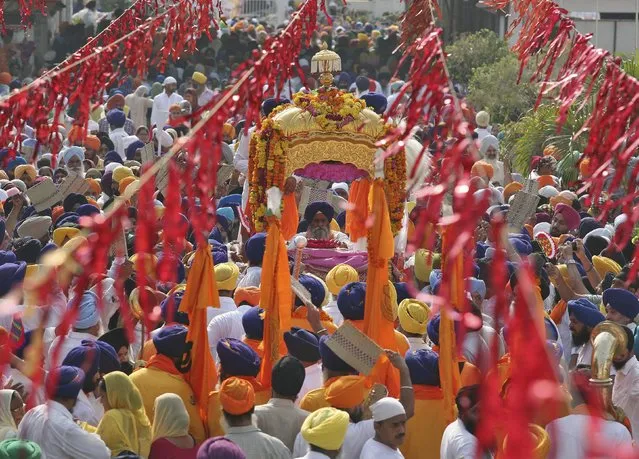
Sikh devotees carry their holy book Guru Granth Sahib in a palanquin during a religious procession inside the premises of the Golden Temple in Amritsar, India, September 14, 2015. (Photo by Munish Sharma/Reuters)
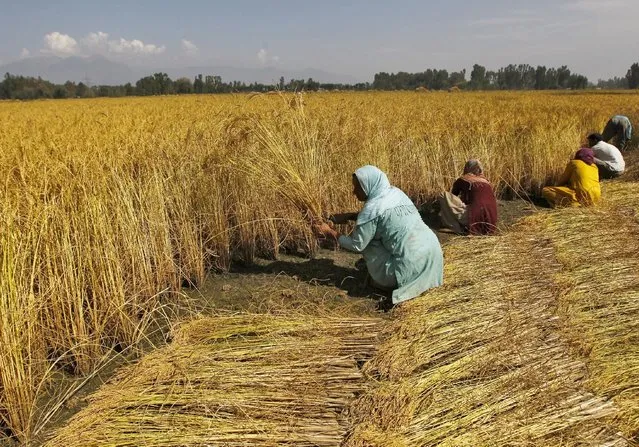
Kashmiri farmers harvest paddy crops on the outskirts of Srinagar September 14, 2015. India's wholesale prices tumbled for a tenth straight month in August, pressured by falling fuel costs, bolstering prospects of an interest rate cut by the central bank later this month. (Photo by Danish Ismail/Reuters)
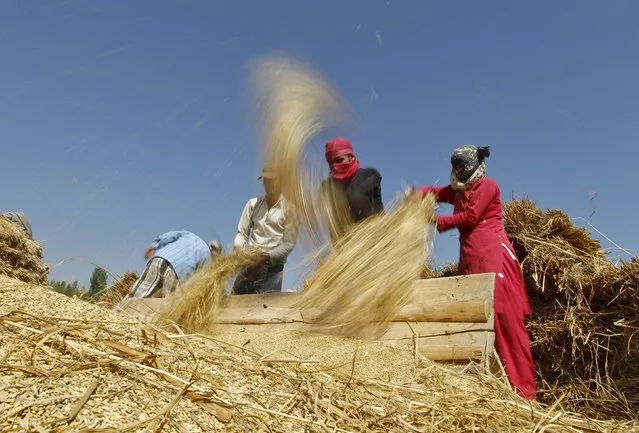
Kashmiri farmers thrash paddy crops on the outskirts of Srinagar September 14, 2015. (Photo by Danish Ismail/Reuters)
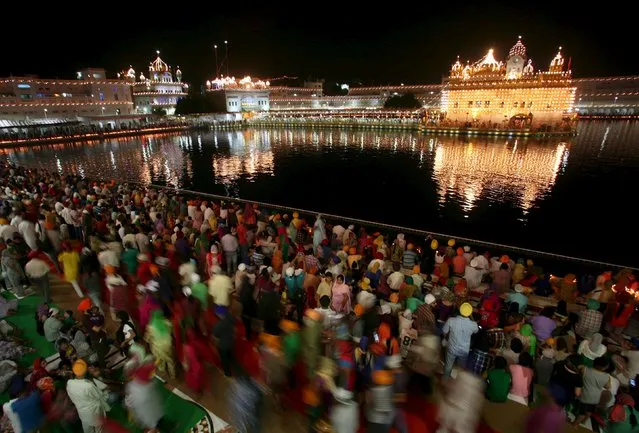
The Golden Temple is seen illuminated as Sikh devotees throng the shrine on the 411st anniversary of the installation of the Guru Granth Sahib, the religious book of Sikhs, in Amritsar, India, September 14, 2015. (Photo by Munish Sharma/Reuters)
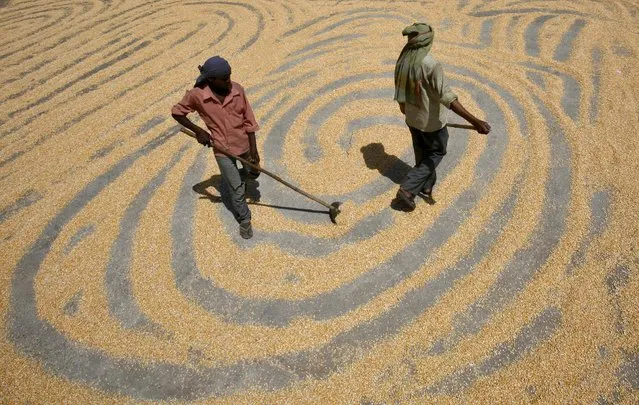
Workers spread maize crop for drying at a wholesale grain market in the northern Indian city of Chandigarh in this June 12, 2012 file photo. India's summer-sown corn output is likely to drop more than 15 percent in 2015 as the first back-to-back drought in three decades wilts crops and forces farmers to let land lie fallow, trade and industry officials said. (Photo by Ajay Verma/Reuters)
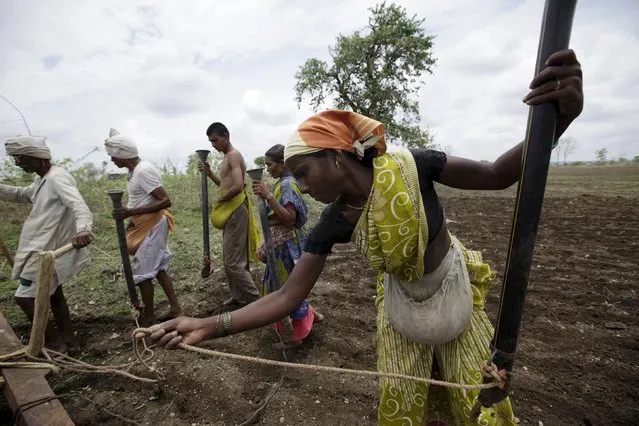
A family work in a field sowing soy beans in the village of Wardha, near Nagpur in the state of Maharashtra in this July 3, 2009 file photo. India's soybean yields are likely to drop this year as the first back-to-back drought in three decades wilts crops, offseting an increase in the area under cultivation and keeping output of the oilseed steady near year-ago levels, industry sources said. (Photo by Jorge Silva/Reuters)
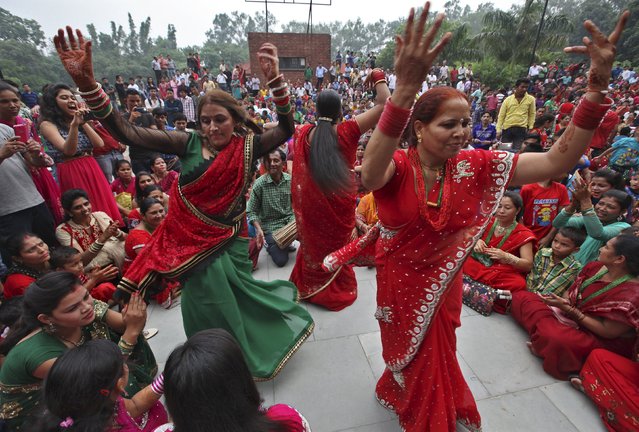
Nepalese Hindu women dance during celebrations for the Teej festival in Chandigarh, India, September 16, 2015. Nepalese Hindu women all over the world fast and pray for the good health and longevity for their husbands during the festival. (Photo by Ajay Verma/Reuters)
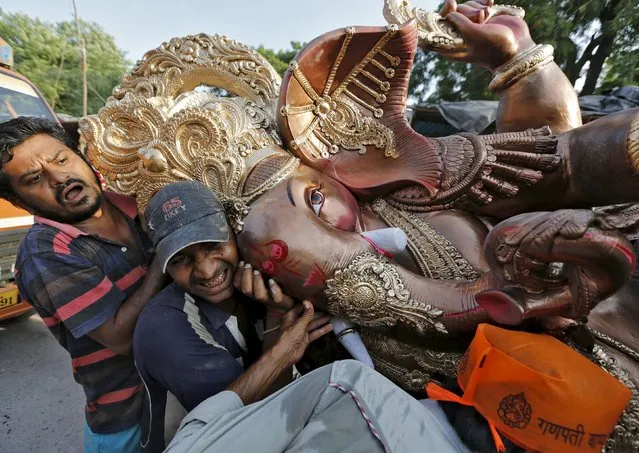
Devotees carry an idol of Hindu elephant god Ganesh, the deity of prosperity, while it is carried to a place of worship in Ahmedabad, India, September 16, 2015. Idols of Ganesh are made two to three months before Ganesh Chaturthi, a popular religious festival in India. During the festival, the idols will be taken through the streets in a procession accompanied by dancing and singing, and will be immersed in a river or the sea in accordance with the Hindu faith. (Photo by Amit Dave/Reuters)

Workers load an idol of Hindu elephant god Ganesh, the deity of prosperity, onto a truck to transport it to a place of worship in Ahmedabad, India, September 16, 2015. (Photo by Amit Dave/Reuters)
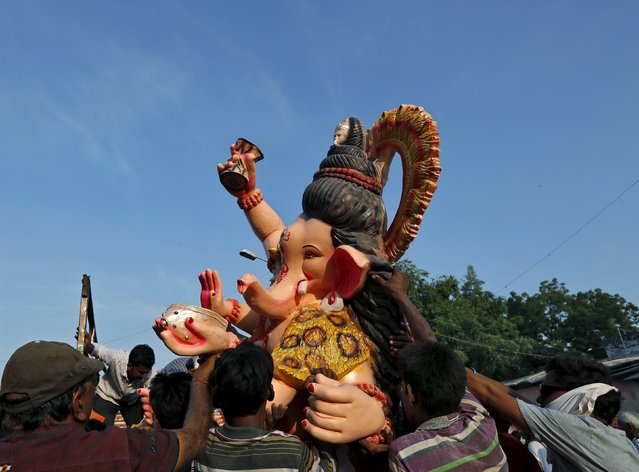
Devotees carry an idol of Hindu elephant god Ganesh, the deity of prosperity, while it is carried to a place of worship in Ahmedabad, India, September 16, 2015. (Photo by Amit Dave/Reuters)
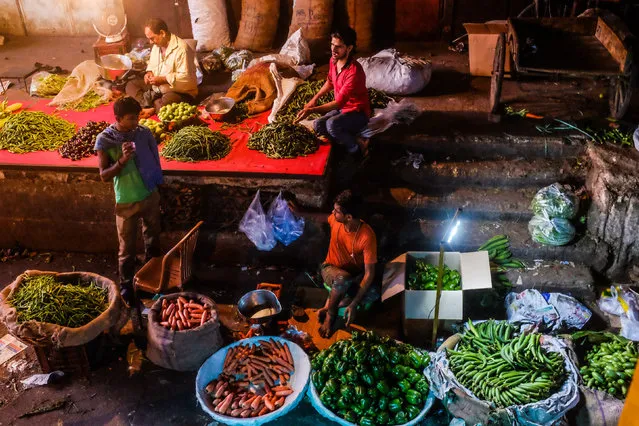
Indian salesmen tend to their vegetable stalls at a local market in south New Delhi on September 9, 2015. The cost of India's staple vegetable – an essential ingredient in curries and eaten daily by almost everyone – soared in August to an eyewatering 60 rupees (90 US cents) a kilo on wholesale markets, up from 25 rupees in June. (Photo by Roberto Schmidt/AFP Photo)

Indian laborers work at a brick kiln in Budgham area, southwest of Srinagar, Indian controlled Kashmir, Tuesday, September 8, 2015. Brick making is an unorganized industry, generally confined to rural and semi-urban areas and is one of the largest employment-generating industries in India. The laborers usually work in hard conditions for 12-14 hours a day to reach a target of 1,000 to 1,200 bricks a day, earning between US$ 100 to 140 a month. (Photo by Dar Yasin/AP Photo)
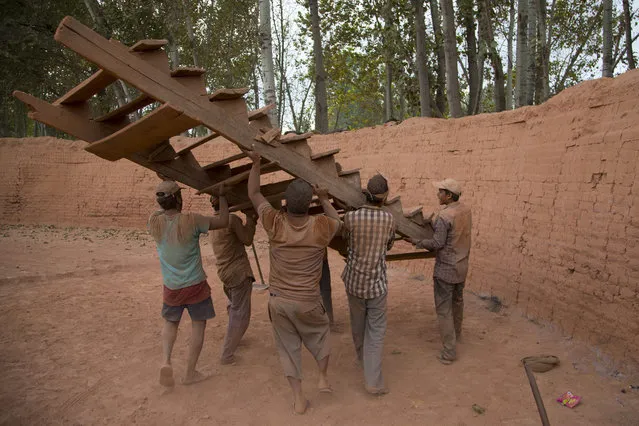
Indian laborers carry a ladder as they work at a brick kiln in Budgham area, southwest of Srinagar, Indian controlled Kashmir, Tuesday, September 8, 2015. Brick making is an unorganized industry, generally confined to rural and semi-urban areas and is one of the largest employment-generating industries in India. The laborers usually work in hard conditions for 12-14 hours a day to reach a target of 1,000 to 1,200 bricks a day, earning between US$ 100 to 140 a month. (Photo by Dar Yasin/AP Photo)
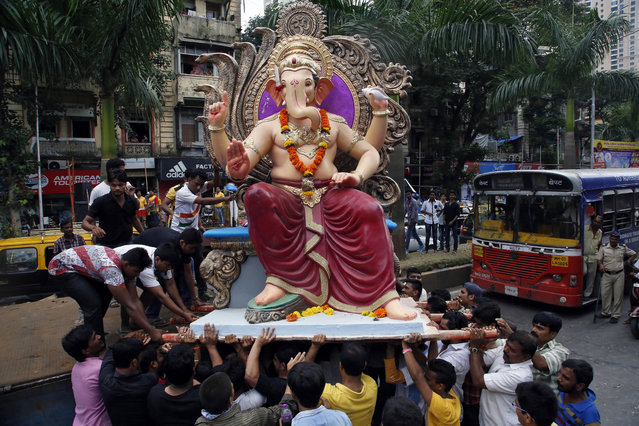
Devotees carry an idol of elephant headed Hindu god Ganesha from a workshop to a worship venue ahead of the Ganesh Chaturthi festival in Mumbai, India, Sunday, September 13, 2015. After worshipping during the ten day long festival, the idol will be immersed in the Arabian Sea. (Photo by Rajanish Kakade/AP Photo)
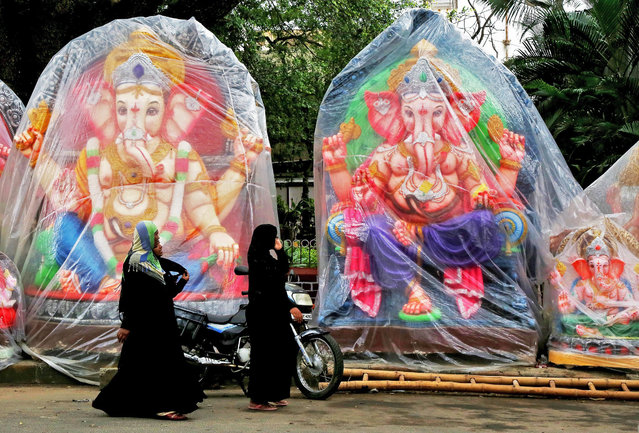
Indian Muslim women walk past idols of Hindu elephant-headed god Lord Ganesh during preparations for the upcoming Ganesh Chaturthi festival at a roadside make-shift workshop in Bangalore, India, 14 September 2014. The ten-day long Hindu festival is celebrated as the birthday of Lord Ganesh and starts on 17 September. (Photo by Jagadeesh N.V./EPA)
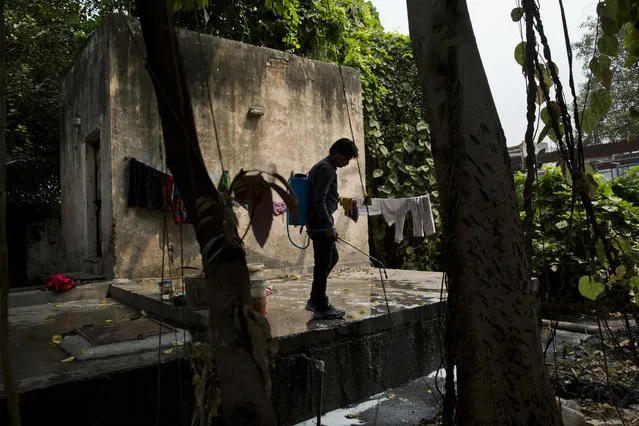
A municipal worker sprays disinfectants on sewage water near a hospital to prevent mosquitoes from breeding in New Delhi, India, Wednesday, September 16, 2015. New Delhi has been hit by an outbreak of the mosquito-borne disease, dengue fever. Nearly 1,900 cases have been recorded in the city's hospitals. (Photo by Bernat Armangue/AP Photo)
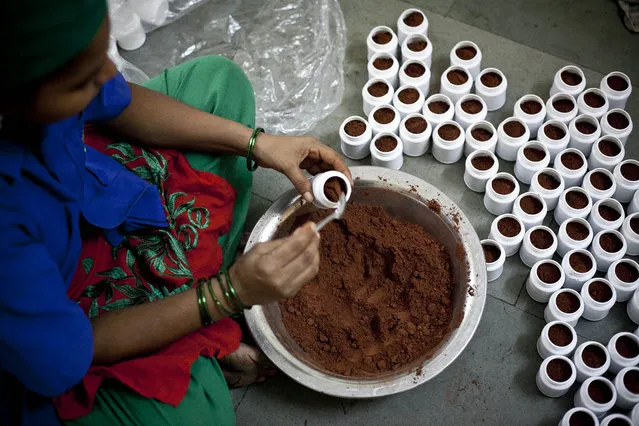
A woman packages toothpaste made from cow waste at the Keshav Srushti cow shelter September 7, 2015 in Thane, India. Earlier this year the Maharashtra government banned the slaughter of cows and the possession of beef. Since the ban prevents people from selling their aging cows to slaughterhouses, the shelters have had an increase of cows being surrendered. There are an estimated 25,000 cow shelters around India that provide cattle with sanctuary from illegal slaughter and comfortable surroundings in which to spend their last years. (Photo by Allison Joyce/Getty Images)
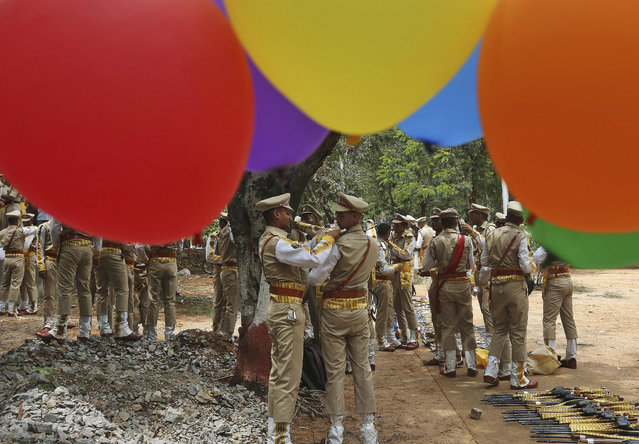
Balloons fly at the National Industrial Security Academy (NISA) as members of India's Central Industrial Security Force (CISF) prepare for a ceremonial parade on the outskirts of Hyderabad, India, Tuesday, September 8, 2015. The CISF is a paramilitary security force which provides security cover to nuclear installations, space establishments, airports, seaports, power plants, sensitive Government buildings and heritage monuments in India. (Photo by Mahesh Kumar A./AP Photo)
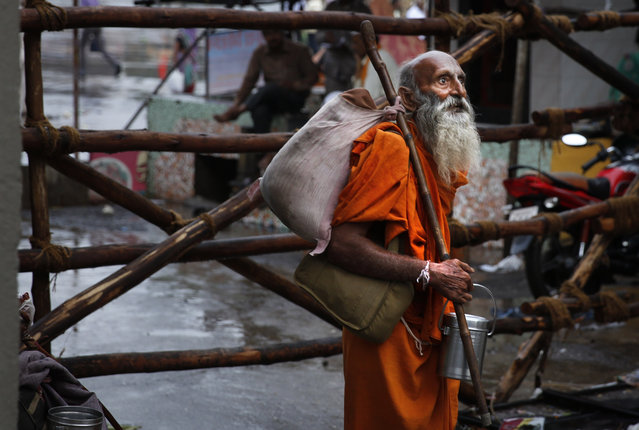
An Indian holy man looks at a temple after arriving in Nasik for the second holy bath in the Godavari River, during Kumbh Mela, or Pitcher Festival, India, Saturday, September 12, 2015. Hindus believe taking a dip in the waters of a holy river during the festival will cleanse them of their sins. According to Hindu mythology, the Kumbh Mela celebrates the victory of gods over demons in a furious battle over a nectar that would give them immortality. (Photo by Manish Swarup/AP Photo)
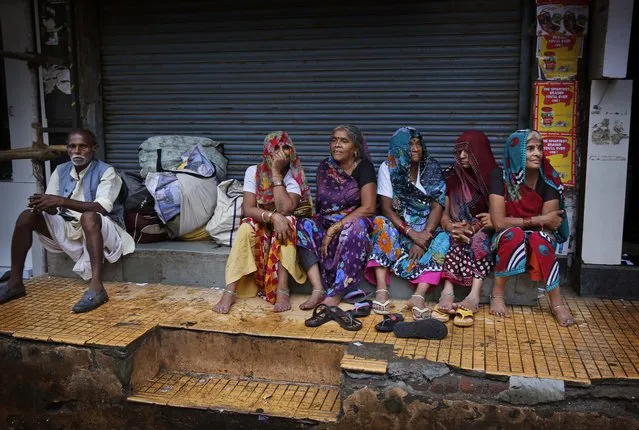
Indian devotees take a rest after arriving in Nasik for the second holy bath in the Godavari River, during Kumbh Mela, or Pitcher Festival, India, Saturday, September 12, 2015. (Photo by Manish Swarup/AP Photo)
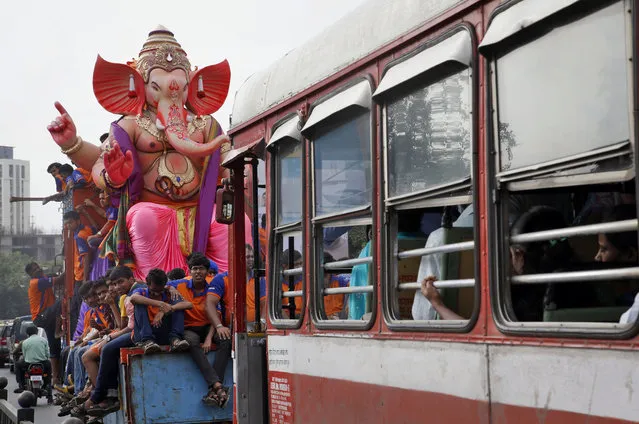
Devotees sit on a truck carrying an idol of elephant-headed Hindu god Ganesha from a workshop ahead of Ganesha Chaturthi festival in Mumbai, India, Wednesday, September 16, 2015. Ganesha Chaturthi, the 10-day festival that celebrates the birth of Ganesha, begins Sept. 17 and ends with the immersion of Ganesha statues in the Arabian Sea and other water bodies. (Photo by Rajanish Kakade/AP Photo)
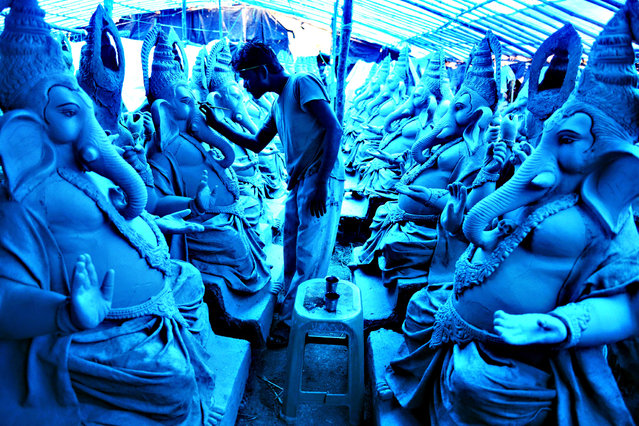
An Indian artist works on eco-friendly figures of Hindu God Lord Ganesh made with mud, jute and bamboo at a blue tarp-covered workshop on the outskirts of Hyderabad on September 15, 2015. The statues of eco-friendly clay Ganesh idols made with mud, jute and bamboo will reduce pollution during the Ganesh immersion. The popular eleven-day long Hindu religious festival, Ganesh Chaturthi will be celebrated from September 17-27 this year. (Photo by Noah Seelam/AFP Photo)
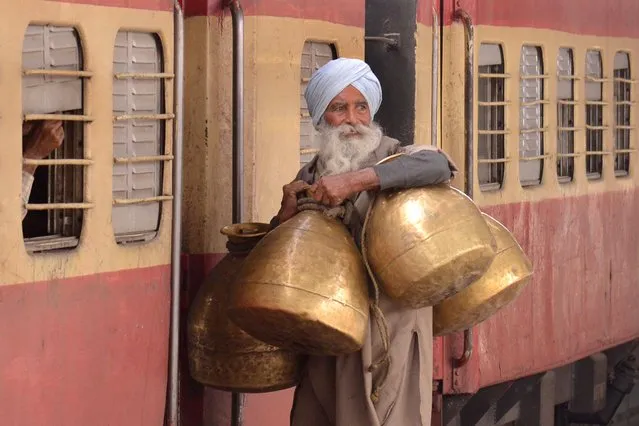
An Indian milkman carries milk containers as he boards a train at a railway station in Amritsar on February 26, 2015. (Photo by Narinder Nanu/AFP Photo)
17 Sep 2015 10:38:00,
post received
0 comments
